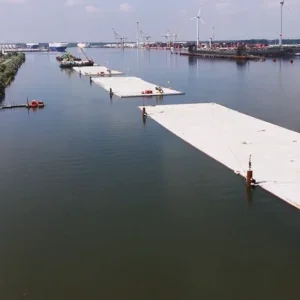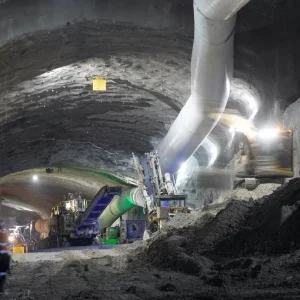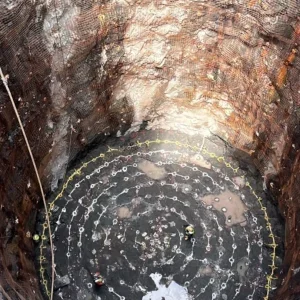IF OUTGOING BRITISH TUNNELLING SOCIETY Chairman Roger Bridge has one piece of advice for his successor, Mark Leggett, who picked up the baton in May, it is "free up your diary". "The role of BTS Chairman is almost a full-time job," said Bridge, who is tunnelling manager at Balfour Beatty Civil Engineering. "And with the increase in the amount of tunnelling in the UK there is even more to the role and a greater reason for engagement."
That engagement has involved working more closely with other learned societies and organisations and also, perhaps more crucially, with clients. And whereas 25 years ago these tended to be individuals, now "larger, much more coherent client bodies", such as TFL (Transport for London), Crossrail, Tideway and HS2 are more prevalent.
Client engagement has been a major, but not exclusive demand on the Chairman’s time. Attention has also continued to be focused on training and education, BTS membership, registration, updating guidance documents and the pitch to host the 2019 ITA World Tunnel Congress in London. In this latter respect the BTS has been unsuccessful, with Naples in Italy being announced as the 2019 host during this year’s event in San Francisco.
"We were obviously disappointed with this result" said Leggett, but added "we wish Naples and the Italian Tunnelling Society every success in running WTC 2019; we still believe that the UK and London would be a fantastic venue for WTC and no doubt we will look for future opportunities to do so." In the meantime, work goes on the home front.
"I’ve always been very keen on training so my goal during my tenure as Chairman was to progress with that and improve the popularity of our Design & Construction and Underground Health & Safety courses," said Bridge, adding that uptake of these is now at an all-time high.
"I also work with TunnelSkills as an offshoot of the BTS and we have identifi ed an absence of an underground survey training capability, so we are developing one, initially for technicians, which will be jointly delivered by TunnelSkills and the Tunnelling and Underground Construction Academy [TUCA]."
Bridge has also worked to increase membership numbers, some of which has involved tightening up on the ‘housekeeping’ but much of which has centred on explaining the benefi ts of membership, particularly to corporate members. At the top of the list of these benefi ts is enhanced client engagement.
The membership drive has been successful and fi gures now stand at more than 800 individual and 78 corporate members – another all-time high Other tasks have included continuing the good works started by former chairmen, such as establishing a registration scheme for tunnellers – as distinct from civil engineers.
"Unlike the Institution of Civil Engineers [of which the BTS is an Associated Society], which is very much aimed at the professional engineers with chartered status, the BTS is an all-inclusive society," said Bridge. "We welcome suppliers and operatives as well as engineers as members because we recognise they all have something to contribute.
"However, as the number of projects rises, clients are increasingly looking for certainty and confidence that operatives have the necessary tunnelling experience and expertise, so we’ve been looking at a registration scheme.
"The Register of Ground Engineering Professionals (ROGEP) is already out there but it’s for professionals and excludes some of our membership, so we’ve been working with them and they are looking at expanding the ROGEP scheme to include all levels of tunnellers.
"It’s much better for us to have a system we can tie into, rather than set up our own," said Bridge. "We haven’t got as far as we would have hoped but we are certainly a lot further forward."
He added that the BTS has also worked with some of the chartered institutes, such as ICE and IOM3 (the Institute of Materials, Minerals and Mining) on developing NVQ Grade 3 holders through the EngTech route in order to bring them through the registration process.
As well as collaborating with ROGEP and the aforementioned TunnelSkills and TUCA, the BTS has also had more engagement with the ICE over the last two or three years and also with the International Tunnelling and Underground Space Association (ITA). "Whereas in the past an Associated Society just co-existed, the ICE now demands more contribution and input from us for their own offering and knowledge sharing. Our experience of running courses and conferences has led to more interface with the ICE."
Interest in the ITA has also grown, particularly as the creation of the BTS Young Members group (BTSYM) seven years ago has been instrumental in the establishment of the ITA Young Members group and similar bodies across the world.
"There is a lot of interaction between the ITAYM and the BTSYM, which is involved in many of the working groups," said Bridge. And, of course, there has been another imperative for the link with ITA, which was the BTS’s bid to host the 2019 World Tunnel Congress.
"The BTS has always had a good input into the worldwide tunnelling sector – our guidance on working with compressed air has become the default document in many countries, for example – but hosting the WTC would have increased our exposure and let the rest of the world know what the UK market is like," said Bridge.
Another benefit would have been the funds the event would have brought into the BTS, which could be used, for example, to develop more guidance documents and/or provide bursaries for the Tunnelling and Underground Works MSc at Warwick University.
New chairman Mark Leggett, who is divisional director of Mott MacDonald’s Metros & Civil Division, says hosting the WTC would have been "a long overdue showcasing of British talent" and that there is an abundance of projects that would have been under way by 2019 to present to the tunnelling cognoscenti.
These include HS2 (Leggett is currently leading the Mott MacDonald HS2 London Metropolitan hybrid Bill team), Thames Tideway, Silvertown, York Potash and, potentially, Stonehenge and Crossrail 2, as well as numerous underground station upgrades. There is also a myriad of smaller diameter tunnels, including flood attenuation works, pipejacks for water authorities and work for the National Grid, the latter including 32km of tunnelling in London. A large amount of work is being dished out, and companies are filling their boots. Notably the Thames Tideway contracts were recently issued, with the East Section being designed by Mott MacDonald for a joint venture of Costain, Vinci and Bachy Soletanche. The West Section is being designed by a design JV of Arup and Atkins for Bam Nuttall, Morgan Sindall and Balfour Beatty. The central section will be designed by Aecom for a JV of Ferrovial Agroman UK and Laing O’Rourke. Bridge and Leggett agree that in their respective 28 and 25 years of working in the tunnelling industry the market has never been as buoyant and the number of major, or ‘glory’ projects has never been so high.
Neither has the wider awareness of the benefits that tunnelling can bring. Bridge recalls a meeting at the Major Projects Association recently where presentations – including one on a film studio development in east London – all led to conversations about tunnels and how they would facilitate access.
Tunnels are now also seen as vital components of other major infrastructure developments. The UK government is keen to harness the "northern powerhouse" and projects such as HS2, HS2 phase 2 and the Trans-Pennine road tunnel [running under the Peak District and connecting Sheffield and Manchester] are all key in permitting this.
Government aside, the British public is also increasingly conscious of how tunnels can improve their quality of life. The BBC’s three-part documentary on Crossrail played its part in raising awareness by metaphorically taking the public underground and demonstrating the process and highlighting the improvements to transport links.
It’s the type of communication Leggett would like to see much more of. "It’s time we started to use technology to bring what is happening underground on our big projects to the general populace – we could do it on the web," he said.
"We revamped our own website a couple of years ago and it’s a really good source of information now," he said. "We’ve recognised that the world has become more digital so we are looking at the different forms of communicating our message and how we should engage with social media such as Twitter."
Leggett believes the BTSYM has an important role to play here. "Younger people are so technologically connected – their information comes and goes in a different way. And they are much more alive to social issues and resilience than we ever were and they have so much access to instant information, which they pass between them. We can learn a lot from them."
In fact, Leggett is keen to harness the energy and enthusiasm of the BTSYM and use it "to the best endeavour". One BTSYM initiative he is eager to pick up on during his chairmanship is the Teacher’s Pack – a series of 10 lessons, comprising presentations, guides and practical worksheets, for delivery to 11-14 year-old schoolchildren.
"They’ve been tested a couple of times in schools and there has been some teacher involvement but we haven’t worked out how to roll it out yet," said Leggett. "Even the Science, Technology, Engineering and Mathematics Network (STEMNET) says it’s difficult to get [teaching aids] into schools, but we’ve got to get those Teacher’s Packs out and I’m hoping we can get STEMNET and the ICE to help with that.
"We educate the industry with our own BTS courses – and I hope we can also offer some more commercial/ insurance type courses and training events, perhaps jointly with the ICE and industry. We also have links with TunnelSkills, TUCA and the MSc course at Warwick but the schools thread is very important.
"Engineering UK has predicted that with the volume of work we will have an annual shortage of 69,000 technicians and engineers across all sectors," said Leggett, adding that peoples’ career choices were often made when still at school and that if tunnelling-specific training and education didn’t kick in until postgraduate level, many will follow other paths.
He’s hoping, too, of course, that further education will gain momentum. "Warwick University’s Tunnelling and Underground Works MSc is a unique course, both by virtue of the amount of support and input from industry and also the fact that the BTS chairs the steering group," said Leggett. "It’s the jewel in the crown for the BTS, and I would like to see more students entering the course each year, more employers providing bursaries and a bigger uptake from industry of the taught modules."
This year will be one of change as the principal teaching fellow Benoit Jones has moved on (to the University of Cambridge) and is succeeded this summer by Alan Bloodworth, formerly a lecturer in civil engineering at the University of Southampton. His stated research interests are in tunnelling, soilstructure interaction, reinforced concrete structures and the use of fibre reinforced polymers in construction.
"Benoit did a fantastic job and we can now build on that legacy," said Leggett. "I’m hugely excited by that and believe that, together with Warwick, we can really grow the numbers on the course and grow demand from industry. We want more people in this industry – particularly clients – to recognise its importance.
He added that some clients, such as HS2, are opening or sponsoring colleges, so care had to be taken to collaborate rather than duplicate effort.
Leggett is also keen to continue Bridge’s efforts to make the BTS "less London-centric" with the revival of regional meetings. The first of these was held in Glasgow last year and was aligned with the 5km-long Shieldhall wastewater tunnel for Scottish Water. The plan is to pick up on other projects outside London and run similar regional meetings. A candidate for this is the York Potash project, which got the go-ahead last summer and which will see a new potash mine established under the North York Moors National Park. The minehead will lie between Whitby and Scarborough and tunnels extending about 16km inland from the coast and up to 14km offshore will mitigate the impact on the environment.
These regional meetings will reflect the "shift in dynamic", said Leggett. "This includes HS2, which itself is setting up in Birmingham. There is some significant tunnelling planned in that area in the future – we have to link with the northern powerhouse."
Leggett will also continue to articulate the benefits of BTS membership and the range of capability afforded by having both individual and corporate members. "We need members to know what they are getting so we will continue to develop the benefits of the different memberships so that it is clearer and more tailored to each category," he said. "And we have more clients joining the society now so I’m thinking about whether we should have a client or owner membership category."
Having fed into the government’s 2010 National Infrastructure Plan the BTS now has a role in the All-Party Parliamentary Group on Infrastructure and Leggett would like to see strengthened support for this and greater involvement. "The link we have with government is hugely important," he said. "We received strong support from the government for our bid for WTC 2019 and I believe that the UK government now really understands and accepts the place that use of underground space has in society and for the development of our infrastructure. After all, London’s success was built on the Tube.
"We want all parliamentarians to see the use of underground space as an option that offers great value and delivers huge benefits."
"We are moving into a time where we’re not just talking about tunnels but about urbanisation underground and putting a lot of traditional surface facilities underground," continued Bridge. "In Hong Kong they are starting to put water treatment facilities underground and, in Europe, some sports halls and event arenas have been moved underground. There is also the concept of residential and office ‘earthscrapers’. There’s a lot to be done and we’re only just starting."
He added that this is an area where the BTS are working closely with Think Deep UK and the ITA Committee on Underground Space (ITACUS) to promote the informed and efficient use of underground space.
Bridge and Leggett are united in their view that the future is looking bright for tunnelling in the UK and, by extension, for the BTS. "Already there is at least 20 years of tunnelling ahead and there will be more projects following that, too," said Leggett. "I am confident about the future – more so than ever – because using underground space is proving its value and the case for tunnelling has never been stronger"







